Tapestries, an ancient textile art form, have been heralded as luxury art, reserved for the wealthy, for millennia. Even today, tapestries maintain their elite status — largely through their inaccessibility to the average person, the intricacy of their design, the patience that details them, and the regal and assertive presence achieved by their long existence. Beginning with the tapestries featured in his solo exhibition in 2013, part of the Future White Women of Azania Saga (2010-2016), Athi-Patra Ruga has continued to explore tapestries as a world-making exercise.
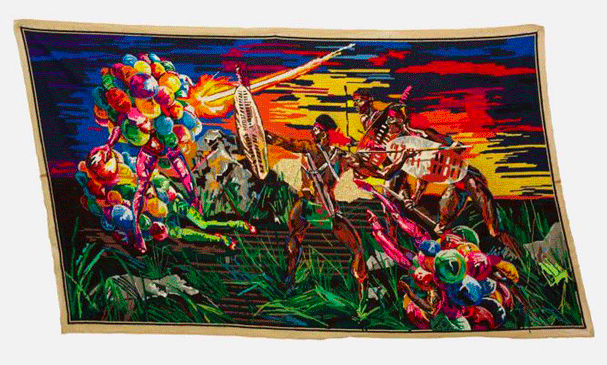
Athi-Patra Ruga is a prolific South African artist and is primarily a performance artist, although he experiments with a wide array of mediums. For Ruga, the body becomes not only a medium for art but a realm of infinite possibility, with each limb stretching into a new social imaginary. Stepping out of his acclaimed and outlandish performance pieces, Ruga still centralises the Black body and the storytelling of his performances in his tapestries.
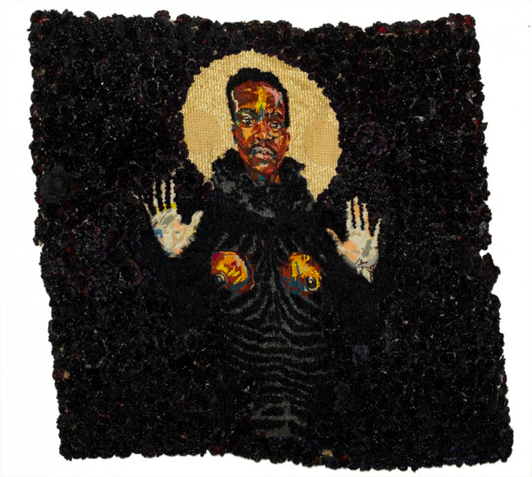
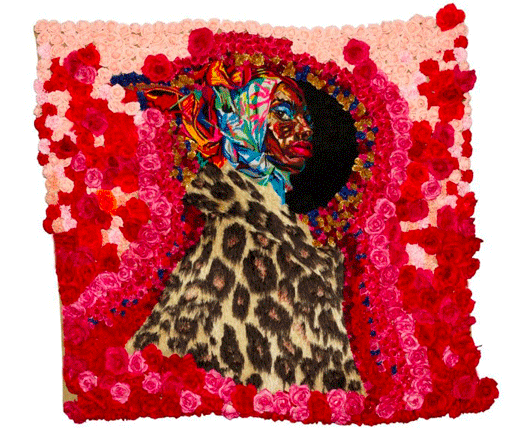
In an interview with The Guardian, Ruga says, “As much as my utopia is inspired by my own black, queer story ... all of my work is in some way autobiographical.”
Athi-Patra Ruga’s tapestries are a medley of character, colour, texture, wonder and curiosity. They entangle the material, magic and memory, and weave together utopian fantasies and reality. In a mix of traditional mediums, such as thread and wool, and non-traditional ones, such as spray paint and faux flowers, Ruga decolonises the historical narratives that continue to shape the lives of Black, queer and femme communities in a post-apartheid South Africa.
With regards to his medium, Ruga said in an interview with New Frame, “I am very aware of the history of the materials I use, which allows me to insert myself and community in there. For instance, tapestry, a very colonial art form, which was taught to me by a German woman in Alice in the Eastern Cape, I use as an expression and a way of documenting my communities.”
With their imaginative spirit, Ruga’s tapestries create a visual justice for past, present and future Black communities as they unveil South Africa’s unfulfilled promises of “rainbow nationalism”, reconciliation and redemption. With this understanding, Ruga’s tapestries look towards the United Nations Sustainable Development Goals for Reduced Inequality and Peace, Justice and Strong Institutions.
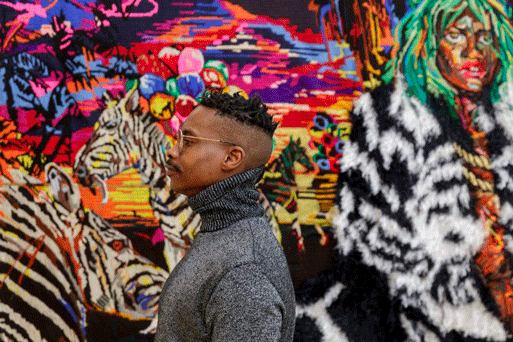
Ruga’s work reads especially powerful in the wake of the #RhodesMustFall Movement, where students protested to decolonise South African campuses and to remove statues and memorabilia of colonizers and imperialists. The protests began by revealing that the visual "evidence" of colonialism and apartheid held a far greater weight than what people recognise — images create realities and inform histories.
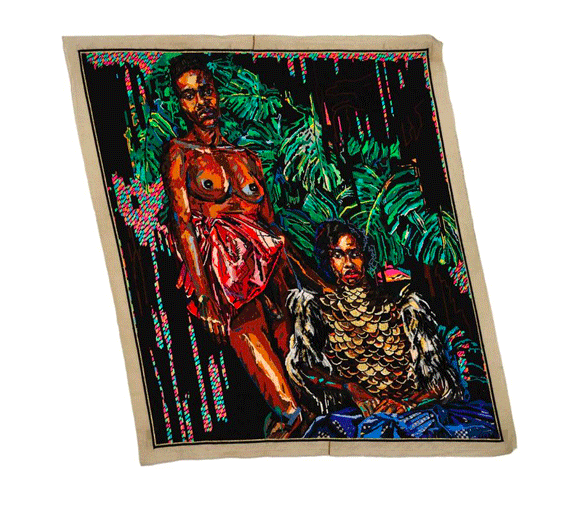
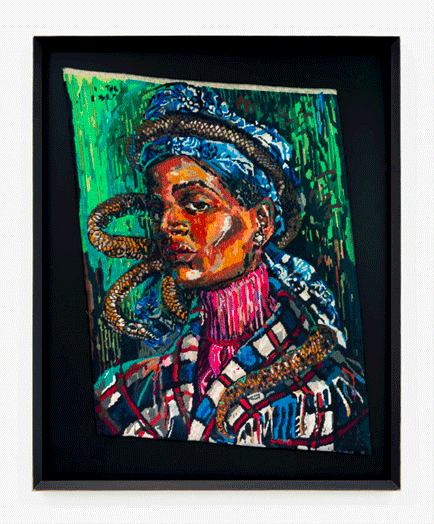
In addressing the relationship between history and the image, the nation imagines the citizen through the lens of whiteness, heterosexuality, masculinity, cisgenderism, able-bodiment. The citizen and the nation lean on one another. Ruga shows that the absences of the archives and the radical erasure, or whitewashing, of history are not without intervention nor reason. It creates a normal and neutral figure against the construction of the “Other”. In his work, Ruga refuses to be the relational “Other”— his queer and femme Black characters are centralised, named and empathised with; his histories are understood.
Ruga’s figures confront the viewer, the gallery, the history of art and of a country. They look back. The tapestries serve as evidence for something beyond themselves. Using his art, Ruga tackles the absence and presence of Black and queer people in visual culture. Ruga queers the likes of the exoticized paintings of Irma Stern, the historical depictions of colonial settlement, and the overbearing statues of white imperialists.
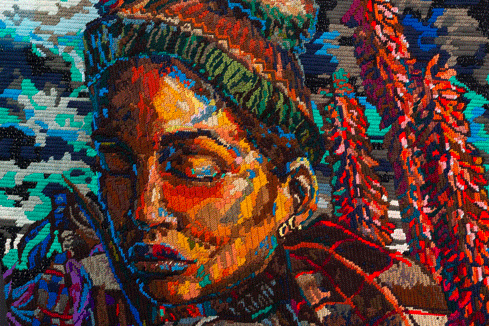
His tapestries offer an alternative history, one that does not benefit from his oppression but thrives with his joy. The tapestries, big and bright as they are, cannot be ignored.
Likewise, Ruga’s Proposed Model for Tseko Simon Nkoli Memorial (2017) remembers Nkoli, an eminent anti-apartheid, gay rights and AIDS activist, with whimsy. Nkoli, resting in a reclined pose, invites the audience’s attention and meets their gaze, instead of bearing down upon them with an authoritarian glare. In stark contrast to the overbearing statues of white imperialists covered in bird droppings, Ruga adorns Nkoli’s statue with faux flowers, diamonds, crystals and pearls, texturing him in a way that breathes life into his memory. Ruga does not erect a grandiose monument to evoke a sense of loss; rather, Nkoli’s statue glistens, blossoms, becomes beautiful in the light.
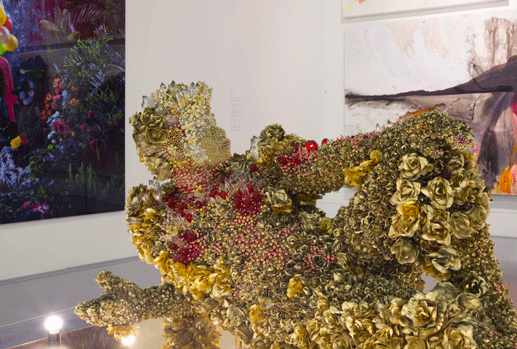
With works like Proposed Model for Tseko Simon Nkoli Memorial (2017) and his tapestries, Ruga highlights that Black queer people don’t just exist, but that their existence matters. For Ruga, hope becomes something tangible. There seems to be as much joy in the process as there is labour. Governed by a new lore, Ruga’s artwork champions a joyous bodily being — one that is eccentric and wild — where Black joy becomes a force of resistance.
Ruga responds to the trauma of colonisation, apartheid and their living legacies within South Africa with grace, with playfulness and creativity. Ruga unravels the things believed to be true and often irrefutable — memory, history, truth. The nation-state is a fable; the colonizer’s history is a fallacy. With thread and needle, Ruga declares that the myths we live by are not the ones that will save us. Instead, he asks us to mend them and make them anew.
See more of Ruga’s work here.
